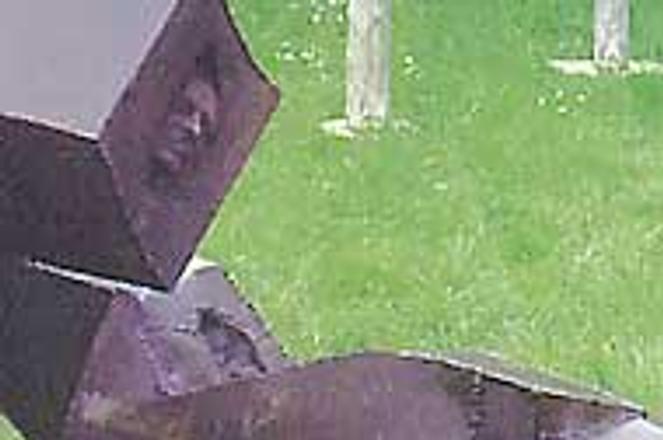THIS COURTYARD construction is called 'dialogue'.photo: Courtesy of Slovak National Gallery
"We spent that night in 1982 with a bottle of wine discussing the social situation," sculptor Juraj Meliš remembers. "I shouted to my friends - make me a death mask, for I'm already dead to this society!"
Meliš, 60, has recently dropped the mask and revealed to the public the full splendour of the work he has been doing, sometimes secretly, for decades.
One of the most famous sculptors in Slovak contemporary art, Meliš has opened an exhibition in the capital called Anvil of Dreams, with works displayed in two different environments - on a courtyard and in the basement of the Slovak National Gallery - symbolising the two different periods during which the artist has worked.
"In contrast to dreams, anvils are heavy, totally within the power of gravity. They drag you down. That's why I chose the name. But dreams are more powerful," says Meliš.
The basement, or anvil part, evokes the communist era, during which he worked secretly, or 'underground', in the privacy of his studio. From the early 1970s until the mid-1980s, Meliš was banned from exhibiting his work in public, as were other artists who had broken the regime's cultural rules.
Under the ban, Meliš would take pictures of his works and send them to his friends, the only way he had of presenting his work and communicating with the world behind the Iron Curtain.
LADIES and gentlemen, something to be found down the stairs.photo: Courtesy of Slovak National Gallery
The courtyard above exhibits works that Meliš created in the freer atmosphere after the 1989 revolution. Massive collages of iron, wood, metal, glass or objects found on the banks of the Danube river are arranged on the grass. Big Censor, a symbol of power, is a 500-kilogramme stone that hangs above wires stuck in the ground. If the stone is moved it strikes the wires in the ground, which represent different ideas.
"It is people who activate the Big Censor. And under such weight, fragile ideas tremble," explains Meliš.
The basement part of the exhibition uses different materials and adds a new theme - the artist's pessimistic vision of the planet's ecological future. The Environment 2 work, formed of dead trees and wooden sculptures of animals in boxes, for instance, depicts the results of human interference with nature.
A special section is devoted to Meliš' visual poetry - words written and burned into wood. Violin strings made of barbed wire, piles of newspapers in an iron clamp as a symbol of censorship, show humour and sarcasm as well as tragedy.
"The absence of human beings in Meliš' works doesn't mean that he doesn't like people. He's just still searching for his identity," says Katarína Bajcurová, the exhibition's curator.
The exhibition runs at the Slovak National Gallery, Rázusovo nábrežie 2, and Esterházy Palace, Námestie Ľ. Štúra 4. Open daily 10:00-18:00 except Monday until September 29. Admission: Sk15-60. Tel: 02/5443-2081.
Author: Mirna Šolić

